The High Priests of Marijuana Fitness
Cool...
o)<
mike
http://priceonomics.com/the-high-priests-of-marijuana-fitness/
The High Priests of Marijuana Fitness
By Alex Mayyasi
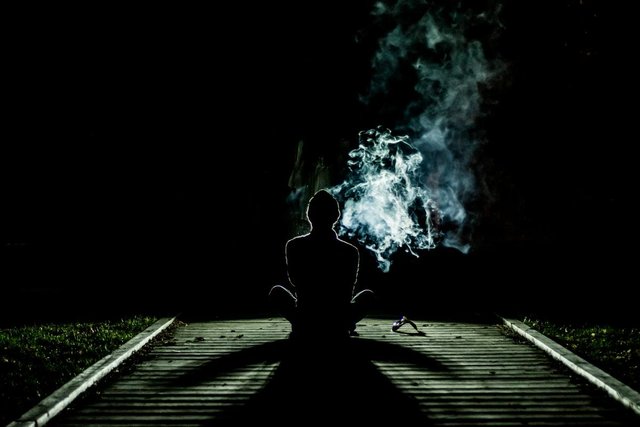
Jim McAlpine’s plan to open the world’s first gym for marijuana enthusiasts is coming along well.
Pot-related businesses are having their moment in the United States, especially in the Bay Area, where McAlpine lives and plans to open his gym, Power Plant Fitness. Arcview Market Research estimates the size of America’s marijuana industry at a fast-growing $7.2 billion, and Y Combinator, the esteemed startup accelerator, made its first investment in a cannabis business—an “uber for cannabis” delivery app—in 2015.
“I’ve raised money before, and it’s been an arduous, shitty process that I hated,” says McAlpine. “This time so far it’s been a pleasure. We’re in the position where we’re picking and choosing who’s going to invest in us. A lot of professional athletes and celebrities want to get involved.”
The amount of press interest has also been insane. Not many gyms have dozens of articles written about them before they open. But not many gyms are co-founded by Ricky Williams, McAlpine’s business partner who is famous for his football career and infamous for the NFL drug tests he failed because he smoked marijuana.
The other reason McAlpine’s plan inspires intense reactions is that it sounds like a contradiction. Most Americans imagine people who smoke weed watching bad movies and eating junk food. Yet McAlpine and Williams want their cannabis-fueled workout regimens to be the next SoulCycle, CrossFit, or PRX.
The two cannabis entrepreneurs want to sell Americans on marijuana as part of a healthy lifestyle—and to create a signature brand in the process. And like Nike with fancy running shoes and Gatorade with sugar water, they're turning to sports and athletes to do it.
One of the first things you pick up at pot-related business events is that the preferred term is cannabis.
Pot and weed sound like something bought from a dealer, and the word marijuana became common in the 1930s when American drug prohibitionists adopted it, figuring that the Mexican word would trigger racist reactions. Cannabis is a respectable word; a name you can build a multi-billion dollar industry on.
I meet Jim McAlpine at the Cannabis Business Summit & Expo in Oakland, California. It occupies a large convention space in the Marriott Hotel, and from afar, it looks like any business conference. (I’ve just missed a talk by Gavin Newsom, California’s Lieutenant Governor.) It is the Expo’s second day, and McAlpine acts like a regular, saying hello to acquaintances and slipping behind the bar at 11 a.m. to grab glasses of water.
For McAlpine, opening a cannabis gym—a place where people can openly smoke as they lift weights, practice yoga, or meditate—is simply creating a space to do something he’s done his entire life. “The world’s first cannabis gym was in my parent’s house,” he says.
McAlpine is an athletic man whose spirit animal is almost definitely a brown bear, and he grins as he explains that his parents never knew that he and his friends smoked weed as they worked out in the garage. When he got older, McAlpine went to the gym with a bong sitting in the passenger seat of his Mazda 626. “I would get bored about 45 minutes in. Every workout, I’d go out to the car at the 45-minute mark… and I’d pork a big one, and my mind was right again. I worked out twice as long because I had that bong hit.”
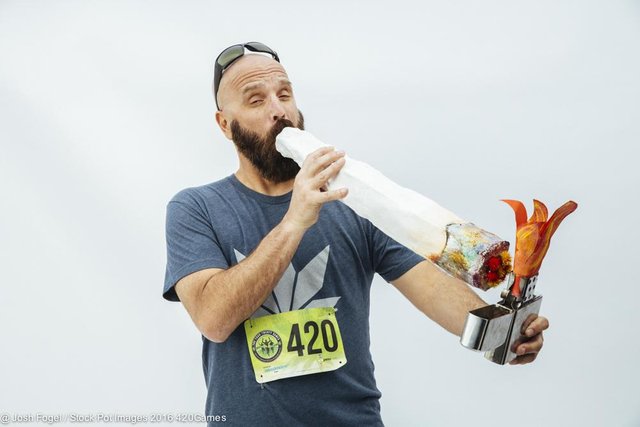
After college, McAlpine founded a ski industry marketing company called Snowbomb. It was best known for throwing annual parties in locations like AT&T Park to celebrate the start of ski season. But when Northern California suffered a string of minimal-snowfall winters, he looked for new pursuits.
He had a knack for throwing events, a belief that the demonization of cannabis kept people from enjoying its benefits, and a sense that public opinion was moving in his direction. So, in 2014, McAlpine created 420 Games, a nonprofit whose mission is “to show that cannabis users are NOT lazy, unmotivated or ‘stoners’, and to de-stigmatize the millions who use cannabis in a healthy and responsible lifestyle.”
This year, 420 Games will host five fun runs. Past events have featured the lighting of a giant, ceremonial joint (an Olympic torch reference), a 4.2 mile run (4/20 is a marijuana reference), and a family-friendly party with beer and live music. Each run takes place in a state that has legalized cannabis; McAlpine encourages people to be respectful if they light up. It’s more event than competition, although cannabis-using athletes who support McAlpine’s mission, like professional marathoner Chris Barnicle, tend to win handedly.
I ask McAlpine if he chose to fight the stoner stereotype through athletics because there’s something visceral about “a stoner” run a five-minute mile, and he agrees. “Athletics speak louder than words,” he says. “You can’t refute athleticism.”
According to McAlpine, cannabis helps athletes in two distinct ways. The first is easy to understand: Marijuana is a painkiller that doctors increasingly recognize as a good alternative to opioids like vicodin. For serious athletes, cannabis offers relief from soreness and bruises.
The second is less intuitive: McAlpine recommends using cannabis to stay focused during a workout, like he did by taking bong hits mid-workout. (To be healthier, he now eats edibles rather than smokes.) “Cannabis really activates my mind in a way where I become focused and engaged in the athletic activity,” says McAlpine. “If I wasn’t using cannabis, I’d be like, ‘This is boring. Let’s turn it in and do something else.’” In reference to people who can’t imagine being active when they smoke marijuana, McAlpine says they probably don’t know the right amount of cannabis to take to feel active rather than lazy.
As the press picked up the story of McAlpine’s Stoner Games, he became a full-blown cannabis advocate. He calls cannabis “medicine” that helps him focus, train, and be a better father, and he refers to the past few decades as “the dark ages of prohibition.” His latest project is creating modern curriculums that teach kids abstinence in an honest way.
“If you crack an egg and say, ‘This is your brain on drugs’, you’re just fear mongering, and it won’t work,” says McAlpine. “My daughter is being told at school, basically, because your dad uses marijuana, he’s a drug addict and not a good person. It kind of makes me angry, actually, that we’re still doing that.”
As McAlpine spent time in the intertwined worlds of cannabis entrepreneurs and cannabis activists, he met Ricky Williams, whose life had been shaped by Americans’ attitudes toward marijuana. Williams won the Heisman Trophy, college football’s highest honor, in 1998. By 2002, he was one of the National Football League’s best players. Then he received a suspension and fine for testing positive for marijuana. Following more failed tests, he abruptly retired, and had to return $8.6 million in salary.
Williams quickly became a late night television punch line. He characterized his subsequent wandering, cannabis smoking, and study of yoga and Eastern medicine as getting well. But fans and the press just called Williams a stoner.
"People were demonizing me like I was the worst person in the world,” Williams recently told The National Marijuana News.
After Williams attended a 420 Games run, McAlpine told him about his idea for a cannabis gym, and Williams agreed to team up. McAlpine is working on the business, and Williams will design the workout regimens, which will integrate cannabis use. Currently, McAlpine is concluding a fundraising process and investigating three potential locations for the gym in San Francisco.
McAlpine and Williams don’t plan to sell cannabis at Power Plant Fitness. Instead they’ll make it easy for their members—who will be required to have a medical marijuana card—consume cannabis mid-workout in a courtyard, smoking lounge, or 40-foot RV turned “consumption vestibule.” So far, backlash to the ‘stoner gym’ concept has not been a problem.
McAlpine is careful to say that cannabis affects everyone differently, and that working out a bit high won’t be for everyone. But he does want people to try it, and he encourages me too. Since I don’t smoke, McAlpine suggests I have a microdose before a workout.
After saying goodbye to McAlpine, I drift through the Cannabis Expo, observing the industry’s maturation. A well dressed woman explains to a radio interviewer how to convince politicians to support full legalization. One attendee tells me that he’s never seen so many insurance companies at a cannabis event. The booth of KIVA, which makes the chocolate edibles that McAlpine recommends I try, looks like a Swiss chocolatier’s setup.
As I admire the KIVA booth, I think about how I’ve eaten chocolate covered espresso beans for a hit of energy before a run. Is having a chocolate edible that different?

Jim McAlpine and Ricky Williams are not the only ones proselytizing the merits of marijuana for athletics.
In the National Football League, team physicians hand out so many painkillers that players have sued the league for fomenting addiction. That’s why retired athletes like Nate Jackson, appearing on Real Sports with Bryant Gumbel, have discussed how NFL players use cannabis as an alternative. “I weeded as needed,” Jackson told reporters, who also interviewed Dr. Raphael Mechoulam, a distinguished researcher who calls the plant “more effective” and “less addictive” than pain pills. Jackson claimed that “maybe half” of NFL players self-medicate with cannabis.
Retired players from many sports make similar claims, and a number of them use cannabis for more than pain management. Tanner Hall says he was high during all his medal-winning runs at the X Games as a freestyle skier. “It helps with the stress, with the anxiety," Hall told the New Yorker. "I’ve used it on a daily basis for about half my life." Former NBA player Cliff Robinson has said that he never competed high, but that he used cannabis to concentrate while working out or shooting jumpers.
The interest extends beyond elite athletics. Seibo Shen, a techie turned cannabis entrepreneur, says cannabis helps him get in a flow state when he bikes and think more creatively during jiu jitsu bouts. A Florida resident who has attended the 420 Games tells me that weed helps him focus, lose his ego, and feel each muscle group he’s working out. Tommy Joyce likes to hit Colorado’s ski slopes with cannabis. “My anecdotal two cents is it’s phenomenal. It’s an energy booster. The creativity and flow.” His company, Black Rock Originals, makes discreet cases that contain the smell of weed; they are popular among Colorado professionals who use cannabis at work for concentration and creativity.
Fitness magazines have picked up on the trend too. In one article, Dr. Iñigo San Millán, a sports physiologist who has worked with Tour de France cyclists, explains that marijuana isn’t performance enhancing like doping—cannabis makes muscles and lungs, if anything, function worse. But, he adds, “in certain situations when reducing anxiety or pain is beneficial, marijuana may be helpful.”
This is all part of what McAlpine refers to as a large and “closeted” world of healthy lifestyle cannabis users. The turnout for his 420 Games and the reaction to the cannabis gym have convinced him that he has many peers, and that they are ready to come out of the shadows. “My inbox is literally jammed with people saying ‘Thank you, thank you. Please, can we work for you? When can we sign up?’” he says.
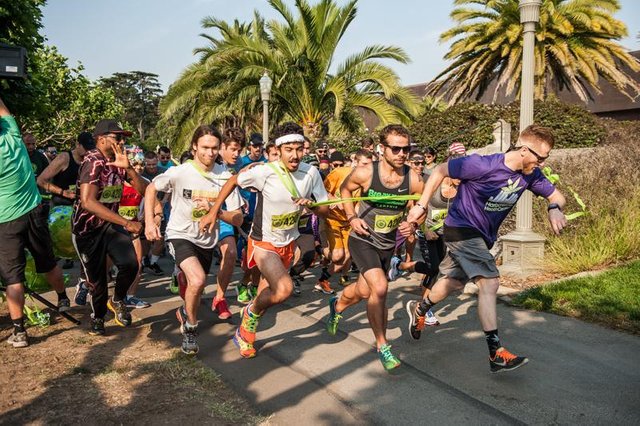
At the starting line of the 420 Games. Photo Credit: Richard Haick
Learning about this world, and hearing from its acolytes, I find their enthusiasm infectious. I am an unlikely convert—I am so resistant to the idea of needing a performance enhacning substance that I won’t drink coffee every day. Still, I have an image of running along the California coast on a cannabis microdose. The scenery takes on a mystical sheen, and I lose myself in the run.
Determined to try, I apply for a medical marijuana recommendation through HelloMD, a cannabis startup that connects people via video chat with a doctor who can recommend medical marijuana. Within hours, I’ve scheduled a call.
In states like New York, medical marijuana is protected like Fort Knox’s gold. Not so in California. I self-consciously justify my request by talking about how a foot condition (I was born with clubfoot) aggravates my post-exercise soreness, but the physician makes clear that I’ll get the recommendation. “You’re going to be fine,” he reassures me.
A few minutes later, I have a doctor’s note that allows me to buy medical marijuana. Following a little paperwork at a dispensary that also sells the paintings hanging on its walls, I buy the edibles McAlpine recommended. At home, I eat a small edible (5mg of THC), twiddle my thumbs for 45 minutes, and lace my shoes for a run.
This being San Francisco, my normal run is a tour of weed history, passing Hippie Hill, the epicenter of the 1967 Summer of Love, and people selling marijuana in Haight-Ashbury. But I never feel high. When I get home, still feeling normal, I decide that I’ll take a larger dose next time. (The idea had been to err on the side of taking too little.)
Forty minutes later, I am chatting with my roommates and stuffing my face with takeout. Is this the munchies? Or the effect of a seven-mile run? An hour later, I feel nauseous. I stand up, and blood rushes to my head. “I suddenly feel really high,” I tell my roommates as I walk to the bathroom.
The next thing I remember is waking up on the floor of my apartment with a bump on my head, an elevated heart rate, and my roommates, both medical students, asking me if I know the time and date.
I’ve passed out in my hallway.
Was it foolish to mix weed and exercise? I survive my ordeal with nothing more than a bruise, but it sends me running from the world of freethinkers and anecdotes to the domain of licensed professionals and hard evidence.
The problem with searching for a medical consensus on weed, however, is that you can find a professional to support whatever you want to believe. One cannabis researcher, Dr. Reese Jones of UCSF medical school, tells me that countless studies failed to find any evidence that marijuana worked any better as a painkiller than a placebo. Fifteen minutes later, I watch a recorded talk by a UCSF oncologist, Dr. Donald Abrams, in which he describes cannabis’s fantastic applications as a painkiller. He decries the lack of research conducted due to the federal government’s classification of cannabis as a Schedule I drug “with no currently accepted medical use and a high potential for abuse.”
Still, the future of cannabis for pain management among elite athletes seems increasingly secure and medically-approved. As Dr. Perry Solomon, Chief Medical Officer of HelloMD, explains, athletes can overdose on opioids, but it’s simply impossible to die from a cannabis overdose. Pharmaceutical companies are lobbying against medical marijuana because its popularity threatens the market for painkillers, and the NFL is considering the benefits of cannabis for its players.
Whether amateur athletes should use cannabis to relieve soreness is less clear. Cannabis is a drug that has downsides—including, Dr. Jones points out, addiction. But according to Dr. Solomon, talking about addiction rates with cannabis is hard, because proponents and opponents can’t agree on what constitutes addiction versus healthy use.
Scientific conclusions that link cannabis to athletic focus are even harder to come by. Researchers can easily discuss the connection between coffee and productivity because they can look at how caffeine affects our biology. Cannabis famously contains THC, which is responsible for weed’s psychedelic effects. But it contains many more active ingredients—in differing quantities depending on the product or type of cannabis flower—that cumulatively have different effects.
Dr. Solomon says cannabis has been noted to help with focus on repetitive activities, but calls the question of whether it helps with athletics “more of a personal thing.”
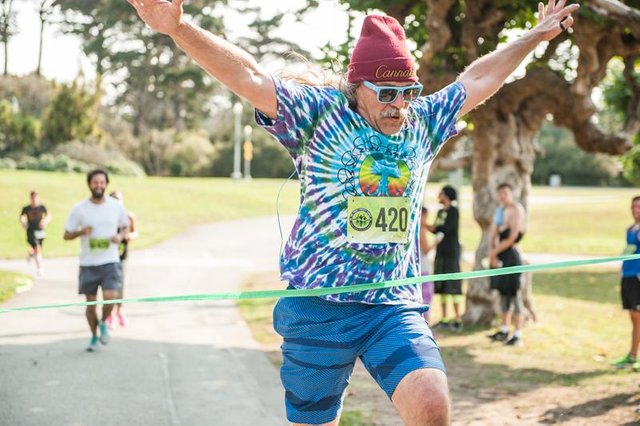
A competitor at the 420 Games. Photo Credit: Richard Haick
The experiences of McAlpine, Ricky Williams, and other athletes who use cannabis are valid. But I am stuck on the fact that they seemingly view cannabis as a cure-all. They tell me that cannabis helps them concentrate at work, feel energized in the gym, be less materialistic, and be a better spouse. It sounds too good to be true, especially without validation by objective outsiders.
Scientists today mostly research the pain management applications of cannabis. But there was a time when they investigated every possible use of psychedelics: the sixties. And reading that research is a trip down the rabbit-hole.
Just as it can be difficult to imagine cannabis helping athletes focus, it seems implausible that psychedelics like LSD could, say, help an engineer improve circuit design. Yet in 1966, researchers associated with Stanford and other institutions gave mescaline to 27 men who had an intractable problem in their research or at work. With the help of psychedelic experience, the men came up with patentable engineering ideas and architectural designs approved by clients.
It was a heady time. In a recent New Yorker, Michael Pollan noted that “the federal government spent four million dollars to fund a hundred and sixteen studies of LSD.” Researchers supplied psychedelics for therapy, exploring spirituality, and inducing creativity. The founder of Alcoholics Anonymous even wanted to use LSD to treat alcoholism. Then the federal government classified cannabis, LSD, and other psychedelics as highly dangerous, banning most research and medical use.
The research had its risks and faults. During an experiment that sent divinity students using LSD to a church service, one had to be restrained and given an antipsychotic after he started ranting and running down a busy Boston street. Yet the successes are incredible. The federal government has cautiously re-sanctioned therapeutic research, and James Fadiman, a lecturer and consultant who studied LSD at Stanford, calls MDMA (better known as ecstasy or molly) “the single best way to overcome post traumatic stress disorder, period.”
What’s tricky about LSD, cannabis, and other psychedelics, though, is that their effects are not linear, like taking ibuprofen. Dosage and mental preparation matter. Since cannabis and LSD are illegal, the stereotypical use of them is to take a lot in order to get fucked up. But in the sixties, researchers carefully selected dosages and trained people to benefit from their altered mental states. An increasingly popular, if illegal, use of LSD today is to take a microdose before work. It doesn’t induce hallucinations, but it can make everything just a little bit better.
The history of mind-altering substances demonstrates that the way we use drugs defines how we see them. In the 1800s, Pope Leo XIII constantly carried a flask of cocaine-infused wine, which he described as helpful for fortifying the mind when prayer was insufficient. Other adherents included Queen Victoria, Ulysses S. Grant, and Thomas Edison. But the wine was likely much tamer than the purified cocaine that exists today, and perceived as more like a morning coffee.
In the 1600s, though, coffee was relatively new to Europe, and its effects seemed mysterious. Members of the clergy asked Pope Clement VIII to ban the drink, which some Europeans embraced as the drink of commerce, while others saw it as dangerous or sinful.
Pope Clement decided that he liked coffee. But had he not, coffee might now be a party drug, consumed six espresso shots at a time.
Since I have only experienced cannabis a handful of times, I chalk up my disastrous first experience with weed and athletics to a learning curve—like I had when figuring out my alcohol tolerance.
Jim McAlpine is alarmed to hear that I fainted and relieved that I’ll try again. He believes that athletes should be able to use cannabis unsupervised, the same way they can buy herbal remedies and supplements like glucosamine (a common treatment for arthritis). But McAlpine apologizes for how my first try went, and asks that I use cannabis the way he plans to introduce it to customers in the gym: by working with a trainer who is knowledgeable about cannabis.
Since McAlpine and Williams are out of town, I meet with Seibo Shen, the successful software salesman turned cannabis entrepreneur. Shen is helping develop “cannabis performance assessments” for Power Plant Fitness, and he has his own budding business, Cannathlete, to teach people to “train like a champion” using cannabis.
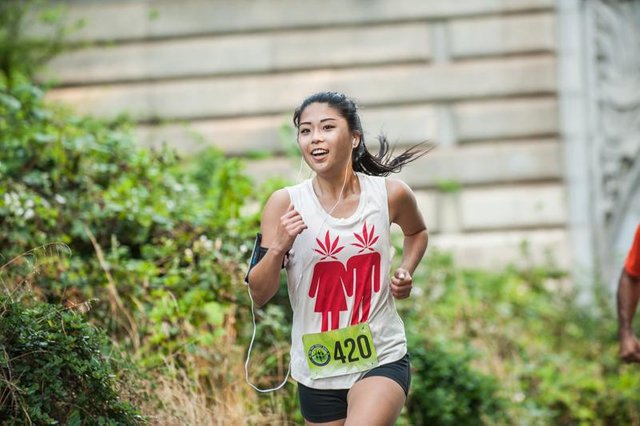
Photo Credit: Richard Haick
Shen is a wiry 39-year-old whose words would hug you if they had physical form. He tells me he respectfully disagrees with McAlpine’s suggestion to take an edible: the potency of edibles can vary depending on factors like when you last ate, making its effects like Russian Roulette. (Doctors I spoke to offered similar explanations of why I passed out.)
Shen prepares some cannabis in the $400 vaporizer his company sells—he says that all-star athletes rank among his customers—and explains in a voice that is half therapist, half camp counselor that we’ll take a small hit, get a baseline, and do some light exercise. Shen’s friend, an accomplished jiu jitsu competitor named Denny Prokopos, leads the process.
I feel like an uninitiated college student as I cough after my hit. But I relax as we talk about consciousness and Prokopos leads me through breathing exercises, stretches, and some pushups. For Shen and Prokopos, their cannabis workouts are about body, mind, and soul. They want me to “get to zero”: no thoughts. Shen knows how they sound. He tells me he’s always thought of himself as a “very analytical person and not someone that falls for hippy stuff.”
When we finish, Prokopos asks how I feel. “Really good,” I respond. I don’t know if cannabis contributed. I don’t feel high; I feel the way I do after a relaxing yoga class. But I’ve handled the cannabis fine, and a few days later, Shen lends me a vaporizer pen and recommends a strain and dosage of cannabis.
I decide to go for a run again, slowly consuming the cannabis Shen recommended.
Once I leave my apartment, I take a hit from the vape pen. The effect hits me quick: the thick San Francisco fog hiding the trees in Golden Gate Park takes on a kind of vibrancy. I feel energetic and happy as I follow a mix of sidewalks and trails to the ocean. After two miles with no bad consequences, I pull out the vape pen and take another small hit. I do the same twice more during my run.
The cannabis does not mask all pain. When I get a stitch in my side, I have to slow to a walk until it subsides. Nor does it focus me entirely on the present. My thoughts still wander as I run.
Instead, I just feel good—optimistic and energized.
I experience the feeling of being winded and, by the end of the run, my legs being sore. But it feels like the connection between my fatigue and the desire to stop is gone. At mile six, I pass a runner who has a knee brace. His face is red, and he grimaces with each step. Normally, I would look like him. But this time, I just think, “Poor guy,” as my feet rebound off the asphalt like springs.
When I reach my apartment, I check my time. During my previous best effort on a seven- to eight-mile run, I averaged an eight minute and 13 second mile time. On this run, I averaged seven minutes and 39 seconds.
One of my roommates asks how my run went. I respond without hesitation: “Best run of my life.”
Although McAlpine and Williams have yet to finalize the location for the first Power Plant Fitness, the reaction from investors, journalists, and customers has inspired them to think ahead.
“Whether its franchising or licensing, I want to see these [gyms] across the United States,” McAlpine says, adding that he’s already looking at locations in Los Angeles and San Diego. “I want create a new paradigm of working out that people can subscribe to, just like PRX and CrossFit. I think we can be the next big thing.”
Beyond financial goals, McAlpine says he’s excited to open gyms in less liberal states, where it won’t be as warmly received. “Controversy breeds discussion, and I think this can open eyes.”
It’s a dream that faces plenty of obstacles, given that cannabis is still illegal in 25 states and under federal law. Then again, plenty of other companies and athletes are assuming the mantle of a cannabis-athletics brand. Skier Tanner Hall has signed a sponsorship deal with Black Rock, the cannabis accessories company. Retired basketball pro Cliff Robinson and former gold medal snowboarder Ross Rebagliati have launched medical marijuana businesses. Ricky Williams has sponsorship deals with a number of other cannabis companies too, and NFL players are advocating for medical marijuana.
The halo of elite athletes is a powerful marketing force, and Americans will buy anything that promises better results. When journalist Christopher McDougall wrote that a secretive tribe of ultra-runners ate chia seeds, sales of chia seeds surged. High school athletes overuse creatine, protein powder, adderall, vicodin, and anything that seems like it could give them an edge. Michelob Ultra is one of the only mainstream domestic beers whose sales increased in the U.S. recently, and it’s thanks to a “healthy lifestyle” marketing campaign that puts its beer in the hands of the yoga pants crowd.
The day after my cannabis-fueled run, I jog another eight miles, aided by hits from a vape pen. I’m not convinced that I want to use cannabis regularly when I work out. But the gains are impossible to ignore. I cut another 17 seconds off my mile time, and whereas long runs once left me feeling dead-tired but satisfied, I still have the energy to conquer the world. Except I feel too optimistic and pleased to want to conquer.
Endorphins and the runner’s high are what get us off the couch and into the gym. They make exercise enjoyable enough that we can, at times, resist television and easy, stationary pleasures.
But running high is an experience I might just crave.
"I enjoy smoking cannabis and see no harm in it." - Jennifer Aniston
I'm a certified gym trainer, please hire me :P
Please do more articles but with less words, so you have a series of articles! I think all of us will appreciate this!
I began to incorporate cannabis into my training about a year ago and I can definitely speak to it's benefits. I'm so glad to see the proactive issue based cannabis community building itself I will certainly find my way to the 420 games. Also, running high is an experience I too crave. Peace